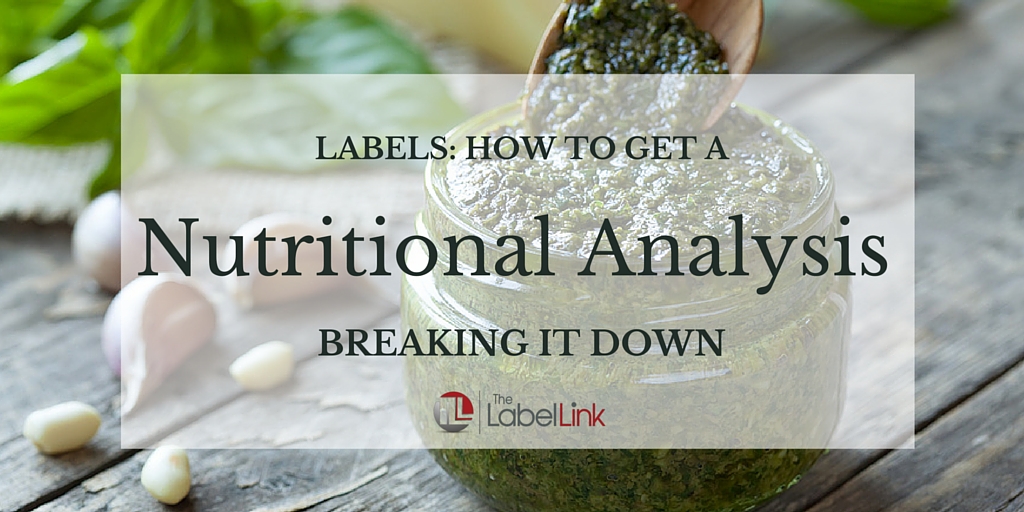
Breaking it Down: How to Get Your Nutrition Analysis for Your Labels
You need to post the breakdown of nutrition in your food or beverage product. Not only is this helpful information for your consumers, but nutrition facts labels are often a requirement by the U.S. Food & Drug Administration (FDA).
Where do you find this breakdown? How do you get a nutrition analysis that’s accurate?
That’s the big question that hinders many businesses from moving forward with their product labeling. You want to use the most accurate facts and figures, but where do you start? How do you know what you’re putting on your label is correct?
Database Analysis vs. Lab Analysis: What Do You Need?
Many businesses believe that they have to send their food into a lab to have it analyzed. Although many companies go this route, it’s not required.
On the FDA website, it says, “FDA has not stated how a company should determine the nutrient content of their product for labeling purposes. Therefore, there is no prohibition from using “average” values for its product derived from databases.”
There are two types of analysis you can have done to determine the nutritional content of your food.
- Database analysis
- Lab analysis
On average, lab analysis are the most accurate, but they’re also the most expensive. Many will cost a minimum of $700. For food and beverage manufacturers wanting to break into the market, this can drain their budget.
A database analysis is equally acceptable but it is far cheaper, averaging around $200 per product.
The pricing might make it seem like a no-brainer but there are other factors to consider. Let’s break down the biggest differences between the two.
Accuracy
As I mentioned, a lab analysis tends to be more accurate. This makes sense. Instead of using a database of ingredients to determine the nutritional makeup of your product, you’re using specifics found in a laboratory for your exact food or drink.
This accuracy is only short term. In some cases, a database analysis can be more accurate in the long run.
Because you will probably only send your product to the lab for testing one time (unless you want to pay more), you will only have the analysis for the specific process you checked. However, over time, your product preparation plan could change. You might vary your cooking methods or alter ever-so-slightly the ingredient list. This can have a direct impact on your nutrition analysis but you won’t see the results in your lab analysis.
If your product is heavily processed, database analysis isn’t always accurate either. Many nutritional features are altered during significant processing. For example, it’s hard to measure how many vitamins and minerals are being lost during the cooking process.
Timing
If you choose to use a lab analysis for your products, you must send your food product in for testing. It can take days for your product to reach the lab and even longer for your product to be tested. This might not be an issue if you’re not in a hurry. If you are under pressure (like most businesses) to get the nutrition analysis completed, waiting for the lab results could set you further behind than you’d like.
Database analysis is much faster. Instead of it taking a few days or weeks, it takes you a few hours maximum to get the results.
Finding Your Ingredients
Perhaps the biggest challenge with a database analysis is finding your ingredients. There are many factors to consider.
You must find the ingredient breakdowns from your suppliers if they’re not in the database. This is usually only a challenge for products with highly unique ingredients, such as protein bars made with crickets. Most ingredients are listed in the database already.
The harder part tends to be weighing and measuring accurately before and after cooking. This can pose a challenge if your product is processed with marinades or cooked in a deep fryer. It’s difficult to determine how much of each ingredient is absorbed during the creation process.
Question: What do you think you’ll opt to use?
The FDA does not state a preference when it comes to finding the nutrition analysis in your products. It’s up to you what makes the most sense for you and your customer. If you’re on a shoestring budget, the database approach will make the most sense. If you have a little more flexibility in your spending but you need a highly accurate result, you’ll want to send your product off to the lab.
If you need more help with your nutrition facts labels, we encourage you to call The Label Link at 877-836-8337. We’re available to answer your questions and guide you to the best solution for your specific business.
